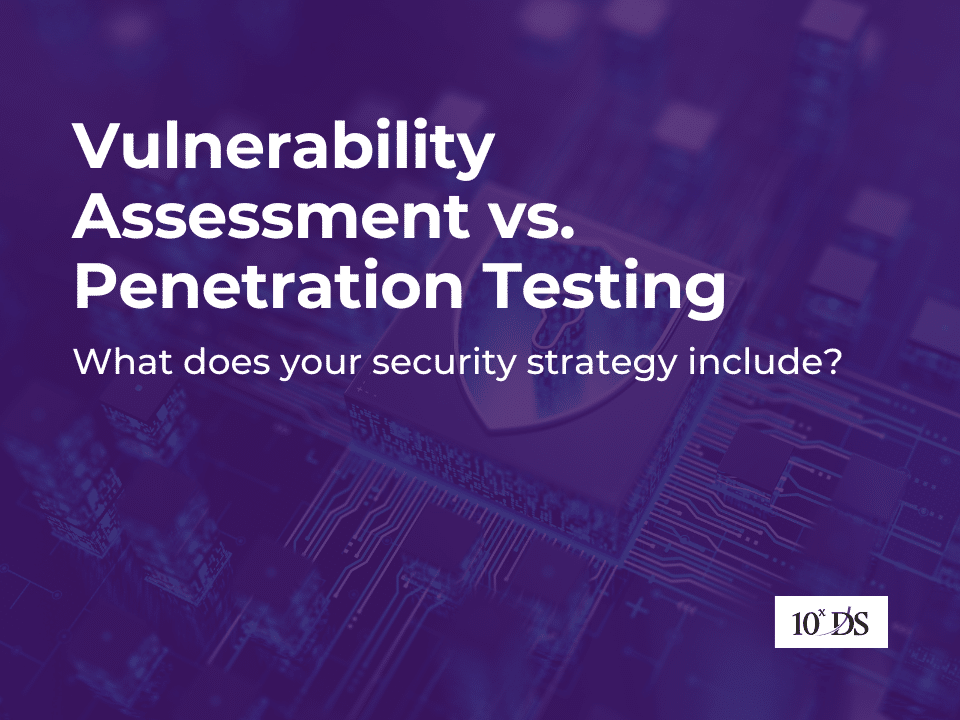
Vulnerability Assessment vs. Penetration Testing – What does your security strategy include?
In today’s digital landscape, cybersecurity threats are evolving rapidly, with 46% of all cyber breaches impacting businesses with fewer than 1,000 employees and the global average cost of a data breach reaching $4.88 million in 2024 . A robust security strategy is essential to protect sensitive data, maintain business continuity, and comply with industry regulations. Vulnerability Assessment (VA) and Penetration Testing (PT) are critical components of this strategy—VA helps organizations identify and prioritize weaknesses, while PT validates how attackers could exploit them in real-world scenarios. For example, phishing and stolen or compromised credentials were the most common initial attack vectors, responsible for 16% and 15% of breaches, respectively. By integrating both Vulnerability Assessment and Penetration Testing, businesses ensure they are not only addressing known risks but also testing their defenses against sophisticated threats, significantly reducing their chances of a costly cyberattack.
Let us try to understand the definitions of Vulnerability Assessment vs. Penetration Testing and then various scenarios including them.
Vulnerability Assessment (VA)
A Vulnerability Assessment is a systematic process of identifying, analyzing, and prioritizing security vulnerabilities within an organization’s systems, networks, or applications. It primarily relies on automated scanning tools to detect known security weaknesses, such as misconfigurations, outdated software, and missing patches. The goal is to provide a comprehensive list of vulnerabilities along with their severity levels, allowing organizations to proactively fix security issues before they can be exploited by attackers. However, VA does not involve actively exploiting vulnerabilities; it only identifies and reports them. This process is typically conducted on a regular basis (monthly or quarterly) to ensure continuous security monitoring and compliance with industry regulations.
Penetration Testing (PT)
Penetration Testing, or ethical hacking, goes beyond identifying vulnerabilities by simulating real-world cyberattacks to exploit weaknesses in a system. It involves a combination of manual and automated techniques to mimic the actions of a real attacker. The objective is to assess how vulnerabilities can be exploited, what kind of sensitive data could be accessed, and how deep an attacker could penetrate the system. Penetration testing helps organizations understand their actual security risks and provides actionable insights for strengthening defenses. However, because this process involves active exploitation, it can be disruptive and requires careful planning. Unlike vulnerability assessments, penetration testing is usually conducted less frequently (annually or semi-annually) due to its complexity and cost.
Scenario 1: Conducting Vulnerability Assessment (VA) but No Penetration Testing (PT)
If an organization only performs Vulnerability Assessments without conducting Penetration Testing, it may have a good understanding of its security weaknesses but lacks insight into how attackers could actually exploit them. VA provides a list of vulnerabilities along with their risk levels, but it does not confirm whether they are truly exploitable in a real-world attack. Some vulnerabilities might appear critical in a VA report but could be difficult or impossible to exploit, while others might seem low-risk but could be chained together by an attacker to cause significant damage. Without PT, an organization might have a false sense of security, thinking that fixing high-risk vulnerabilities is enough, while overlooking deeper attack paths.
Risk:
- Organization may miss real attack vectors and security gaps that attackers could exploit.
- No validation of how effective security controls are against actual threats.
- May waste resources fixing theoretical risks instead of focusing on truly exploitable issues.
An organization that runs regular VA scans and finds an outdated web server but may go easy on it assuming its firewall is protecting it. Without PT, they don’t realize that an attacker could bypass the firewall using a misconfigured rule, exploit the outdated server, and gain access to internal systems.
Scenario 2: Conducting Penetration Testing (PT) but No Vulnerability Assessment (VA)
If an organization only performs Penetration Testing without regular Vulnerability Assessments, it might detect some security weaknesses, but many other vulnerabilities could remain undiscovered. PT is typically targeted and time-limited, meaning it focuses on specific attack paths rather than scanning an entire system for all potential issues. Penetration tests are often conducted once or twice a year, which means new vulnerabilities that appear between tests may go unnoticed. Without VA, an organization lacks a continuous monitoring process to track emerging vulnerabilities.
A company does a penetration test once a year, and testers find a way to exploit a weak password policy. However, they don’t check for hundreds of known software vulnerabilities in the company’s systems that could be exploited by an automated attack. Without VA, these vulnerabilities remain undetected and open to threats.
Risk:
- New vulnerabilities between PT cycles may go undetected.
- Attackers might exploit low-hanging fruit that was never tested.
- No comprehensive view of all security weaknesses, only those found in PT.
Scenario 3: Combining Vulnerability Assessment (VA) and Penetration Testing (PT)
If an organization combines Vulnerability Assessment (VA) and Penetration Testing (PT), it gains the benefits of both approaches—continuous identification of security weaknesses and real-world attack validation. This combination ensures a proactive and realistic cybersecurity strategy.
Step 1: Conducting Vulnerability Assessment (VA) First
A company handling sensitive data, wants to secure its IT infrastructure and they start with a Vulnerability Assessment to detect known security weaknesses across their network, web applications, and cloud systems.
1. Automated Scanning:
- They use Nessus and Qualys to scan for vulnerabilities in their systems.
- The scan identifies outdated operating systems, misconfigured firewalls, and an exposed database with weak authentication.
2. Risk Prioritization:
- The vulnerabilities are classified based on severity (Critical, High, Medium, Low).
- A critical issue is found in an outdated software version on their patient portal.
- Other high-risk issues include a weak password policy and default admin credentials left unchanged.
3. Remediation Actions:
- The IT team patches the outdated software and fixes the weak password policy.
- They reconfigure the firewall rules to close unnecessary open ports.
- Some medium and low-severity issues are left unfixed, assuming they are low risk.
The company believes their security has improved, but they have not tested whether attackers could still exploit other weaknesses.
Step 2: Conducting a Penetration Test (PT) After VA
After fixing the vulnerabilities identified by VA, the company hires ethical hackers to conduct a Penetration Test to simulate a cyberattack and test if hackers could still break in.
1. Reconnaissance (Information Gathering):
- The penetration testers scan the network to find possible entry points.
- They discover a forgotten test server that was not scanned in the VA process and still has outdated software.
- They also find an API with weak authentication that was marked as “Low Risk” in the VA report.
2. Exploitation (Attacking the System):
- The testers use the outdated test server to gain initial access to the network.
- Using weak API authentication, they bypass login security and extract sensitive patient records.
- They chain the vulnerabilities together to escalate privileges and gain administrator access to internal systems.
3. Impact Analysis:
- The penetration testers demonstrate how a real attacker could steal patient data and modify medical records.
- They prove that even low-risk vulnerabilities (when chained together) can lead to severe breaches.
4. Final Security Fixes:
- The company removes the outdated test server that was unintentionally exposed.
- They implement stronger API authentication and restrict access controls.
- They update security policies to ensure that no “forgotten” servers exist in the network.
The penetration test reveals hidden attack paths that the Vulnerability Assessment missed. As a result, the company patches security holes that could have led to a major data breach.
Why Combining Vulnerability Assessment and Penetration Testing is the Best Approach?
Combining Vulnerability Assessment (VA) and Penetration Testing (PT) is the best approach to cybersecurity because it ensures a comprehensive security posture—VA identifies vulnerabilities, while PT confirms if they can be exploited in real-world attacks. VA provides ongoing monitoring to detect weaknesses, whereas PT actively tests an organization’s defenses against potential threats. Relying on only one method creates security gaps; for example, if a company had only conducted VA, they would have missed hidden vulnerabilities like the exposed test server. Conversely, if they had only performed PT, they wouldn’t have systematically checked for all known vulnerabilities, leaving unpatched risks exposed. By integrating both, they achieve complete security validation, closing critical gaps and preventing potential cyberattacks.
Organizations cannot afford to rely on just Vulnerability Assessment (VA) or Penetration Testing (PT) alone—a combination of both is essential for a robust cybersecurity strategy. VA ensures continuous identification and mitigation of known vulnerabilities, while PT provides real-world attack simulations to expose weaknesses that automated scans might miss. Together, they create a proactive security approach, minimizing risks, improving compliance, and strengthening overall defenses. Businesses that integrate both Vulnerability Assessment and Penetration Testing are far better equipped to prevent breaches, protect sensitive data, and maintain trust in an increasingly digital world.
Talk to us to learn more.

